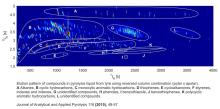Processes for the production of basic chemicals are based almost entirely on fossil resources and predominantly on crude oil. As this is expected to become scarce in the medium term, alternative ways of supplying the chemical industry with basic materials are being sought. One of these possibilities is pyrolysis, in which higher molecular weight compounds are thermally converted into smaller compounds in the absence of oxygen. As a rule, solid, liquid and gaseous products are obtained. Renewable raw materials such as biomass, fossil raw materials such as coal, but also the recycling of plastics (e.g. used tyres) are being investigated as alternative input materials.
The development of innovative technical processes on a laboratory or industrial scale requires a comprehensive and detailed analysis of the products, the composition of which depends on the input material and the process conditions. In this project, analytical methods are being developed to clarify the complex composition of pyrolysis oils of various origins. Two high-resolution instrumental analytical methods are used for this purpose: comprehensive gas chromatography-mass spectrometry (GCxGC-MS) and Fourier transform ion cyclotron resonance mass spectrometry (FT-ICR-MS). Both methods are particularly suitable for analysing highly complex samples such as pyrolysis oils.
In GCxGC, two columns of different polarity are connected in series and linked with a modulator. Compared to one-dimensional GC, GCxGC has several advantages: a significantly higher peak capacity, structured two-dimensional chromatograms and a lower detection limit. By coupling with a mass spectrometer, the separated compounds can be structurally characterised. In a typical pyrolysis oil from coal, biomass or plastic, several hundred to over a thousand compounds can usually be detected. Due to the large amounts of data, the use of algorithms is essential for the analysis. The aim of current research is to derive the structures of as many of the observed compounds as possible in a chromatogram and to develop methods for automatically classifying the compounds into substance classes based on their mass spectra.
Different processes during pyrolysis or in the condensed phase lead to the formation of high-molecular compounds in the pyrolysis oils. As these compounds are not accessible for analysis by GC, they are analysed directly using high-resolution mass spectrometry methods (FT-ICR-MS). Various ionisation methods such as electrospray ionisation (ESI), chemical ionisation at atmospheric pressure (APCI) or various laser desorption ionisation (LDI) methods are being developed for this purpose. Mass spectra of typical pyrolysis oils show thousands of ions with molar masses between 250 and 1000 u, from whose exact masses the sum formulae can be calculated. However, no structural information can be derived from this information, which is why current research is aimed at developing methods for the structural characterisation of these multi-component mixtures using collision experiments.
